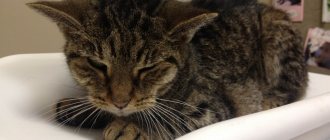Nervous system of a cat
The nervous system functions in close connection with the endocrine system, directing all the vital functions of the cat. The nervous system reacts quickly to both internal and external events. A cat can control some nervous processes consciously, while others are coordinated at a deeper, subconscious level.
[
The nervous system is conventionally divided into two parts - central and peripheral. In fact, the nervous system works as a whole, and many of its elements can be classified as both central and peripheral systems.
The central nervous system consists of the brain and spinal cord - a command center and a kind of "highway" for nerve impulses in both directions.
The peripheral nervous system receives information about temperature, touch, pressure and pain and transmits instructions to the muscles. It consists of cranial, spinal and peripheral nerves.
The cranial nerves are responsible for contracting the facial muscles and transmitting information from the senses. Spinal nerves emerge from the spinal cord along its entire length, connecting distant areas of the body with the central nervous system.
What to do when your cat is nervous
Having an idea of the signs of increased nervous excitability, the owner is able to prevent the development of a nervous system disorder in a pet in a stressful situation (moving to a new place, traveling on public transport or by car, the arrival of a new family member or the arrival of guests, etc.).
In car
Some cats take the forced journey hard: they scream heart-rendingly, rush around the carrier, and try to escape. The animal’s fear is caused by a change in the usual environment, many new unfamiliar smells, and sharp sounds. In public transport, in addition to the smells and sounds of the car, numerous odors of strangers are added, which frightens the animal even more.
Car panic in a furry couch potato can last for hours, exhausting the animal itself and causing inconvenience to the owner. The cat develops increased salivation, rapid breathing, increased heartbeat, and muscle tremors.
The pet does not respond to its name, does not respond to affection, and does not accept treats. This behavior indicates a panicked state of the animal and requires assistance.
First of all, knowing about his pet’s fear of vehicles, the owner should accustom the cat to traveling gradually: first, just let him sit in the car, getting used to the smell, then stay in the car with the engine on, and drive a short distance. It is better to accustom your furry family member to travel from a young age.
When transporting a cat in a car, it is necessary to use a special carrier. A plastic container that provides air circulation to the animal is best suited for this. It can be secured in the back seat using seat belts. Under no circumstances should you carry a nervous animal in your arms. The cat's reaction is unpredictable; it can scratch, break out, get under the pedals and cause a traffic accident.
Serious disorders of the nervous system occur infrequently in cats. However, the owner should have an idea of what symptoms should raise the alarm and seek advice from a veterinarian.
Cat nerve cells
[
The nervous system consists of nerve cells, neurons, and their supporting cells, which produce myelin.
Branches extend from the body of the neuron - dendrites, which receive information from other cells. Each cell also has one long extension, an axon, that sends messages to other nerve cells or directly to organs. All of these messages are carried by neurotransmitters, or chemicals produced in the axons. A cat's nervous system constantly sends and receives a huge number of messages. Each cell sends messages to thousands of other cells.
Myelin is a fatty, protective membrane that covers the largest axons and increases the speed at which messages are transmitted between nerves. A nerve fiber consists of an axon, a myelin sheath, and a cell that produces myelin.
Myelin is produced in the central nervous system by cells called oligodendrocytes, and in the peripheral nervous system by neurolemmocytes. Few nerves have a myelin sheath at birth, but in kittens, nerves myelinate quickly and very efficiently.
Veterinarian at home SAO
“Let the horse think, he has a bigger head!” - is this a familiar phrase? And everything seems to be logical - the larger the brain, the smarter its lucky owner. And there are plenty of examples of this: all sorts of bugs and cockroaches with a brain of a few milligrams, mice, squirrels and titmice with a brain weighing only about 1 gram, and then cats (about 30 grams), dogs (about 100 grams) and apes with brain weighing about 400 grams. - well, they can’t compete with such smart people as you and me, who have, on average, 1400 grams of gray matter. So far, everything seems to be correct.
Well, then complete confusion begins: leaving out all sorts of horses and cows with a brain weight of 300-400 grams, an elephant has a brain weight of more than 5 kg, and sperm whales generally have more than 7 kg! Wow! So this is who they are - the smartest and wisest! No!
It turns out that intelligence depends not so much on the size and weight of the brain, but on the ratio of its weight to the total weight of the whole body. And here man has no equal!
Well, for example: In humans, the ratio of body weight to brain weight is:…. So…. 70 kg divided by 1.4 kg...so.... yeah - 50 times. But in a cow – 1000 times, in a dog – 500 times, in a chimpanzee – 120 times. Well, if you count the “clever” whales and sperm whales, it turns out that their body weight exceeds the weight of their brain by as much as 3000 times!
In general, our only and closest “intelligence” relatives are dolphins, the brain weight of some species of which reaches 1700 grams, with a body weight of about 135 kg.
But I wonder if there is a difference in the weight of the brain, so to speak, within the human race? It turns out yes, it exists!
So, on average, a man’s brain is 130 g. more than a woman's brain. In addition, there are also racial and national differences. For example, the happy owners of the lightest brain are -1185 gr. – are Australians (Australoids), and the heaviest is 1375 g. - Europeans (Caucasoids). At the same time, the English brain weighs, let me remind you, on average -1346 g, and the French -1280 g. The leaders are Germans, their brains weigh as much as 1425 grams. Don't be upset, we are also leaders! Our Russian brain is smaller than the German brain by only about 26 grams! The Koreans are not far behind us - 1376 gr. and the Japanese -1313 gr. But for African Americans, the average brain weight is 1223 grams, which is 100 grams. less than the white population of America. Here are the statistics, dear ones.
But, believe me, the weight of the brain is not the most important thing. So, especially for all kinds of nationalists, fascists, and other “*ists” who are already joyfully rubbing their sweaty hands:
THE LEVEL OF INTELLIGENCE DOES NOT DEPEND ON THE SIZE AND SIZE OF THE BRAIN, BUT IT DEPENDS ON ITS INDIVIDUAL AREAS – THE SO-CALLED GRAY MATTER, WHERE NEURONS ARE ESPECIALLY DENSE CONCENTRATED, AND ALSO ON THE NUMBER OF CONNECTIONS BETWEEN THESE NEURONS.
Don't believe me? For example, the brain of I.S. Turgenev had a weight of 2012 g, but the brain of the famous chemist J. Liebig weighed 1362 g, the brain of “grandfather” Lenin 1340 g, and the writer A. France - only 1017 g. The largest brain, weighing 2850 g, belonged to the patient psychiatric hospital for an epileptic idiot.
In general, I repeat: thinking abilities depend not so much on the size of the brain, but on the number of connections between neurons. In general, some researchers are inclined to think that the presence or absence of certain abilities in a person is determined by the presence or absence of certain special structures in the brain.
Moreover, scientists believe that in the right temporal zone there is a special zone - the “genius block”, with the “switching off” of which creative abilities sharply increase. By the way, perhaps here lies the answer to the question: why are there many talented people among left-handers - after all, their left and right hemispheres of the brain are, as it were, “confused.” Those who are interested can read in more detail about left-handed people on the website www.levshei.net.
Let's continue. In general, our brain is a rather energy-intensive and energy-consuming thing. For example, a “resting” brain consumes 9% of the body’s total energy and 20% of oxygen, while a “working” brain, that is, a thinking brain, consumes about 25% of all nutrients entering the body and approximately 33% of the oxygen the body needs. In general, it turns out that thinking is not very profitable! And even the question arises: why do we need such a large and “voracious” brain?
It turns out that, both in the animal world and in the human world, for survival, in addition to saving energy, another factor is very important - reaction time. And this is where our big brain comes in handy! A person uses it essentially as a large and powerful computer, which turns on when it is necessary to sharply speed up the solution of complex problems that require enormous stress and quick reaction. That’s why, although our brain is insanely gluttonous, it is very necessary and irreplaceable.
So how does this “computer” work?
Is it really interesting? Then further! >>
^ Top
Conscious control and reflexes in a cat
Many functions of the nervous system are under voluntary (volitional) control. When a cat sees a prey, it controls its muscles so that it can more accurately jump on it. Sensory nerves transmit messages to the brain, and motor nerves transmit instructions from the brain to the muscles, causing them to work as the cat needs to jump more accurately. However, other forms of activity may occur involuntarily. Usually this is the activity of internal organs, regulation of heart rate and breathing, and digestion processes.
Such involuntary activity is regulated by the autonomic nervous system, which consists of two parts: sympathetic and parasympathetic. The first stimulates activity, the second depresses it.
When a cat is resting, involuntary activity is controlled by the parasympathetic part of the nervous system: the cat's pupils are constricted, and the cat's heartbeat and breathing are slow and regular. When a cat is nervous, the sympathetic nervous system comes into play: it activates the hypothalamus and pituitary gland of the brain, stimulating the adrenal glands (see above, subsection “Endocrine system”) and preparing a defensive reaction. Blood flows from the internal organs to the muscles; The erector subcutaneous muscles cause the cat's fur to stand on end, the heart rate to increase, and the pupils to dilate so that the cat can see better.
Human thinking is connected with cooking
Waiting times will be reduced: Jaguar will have electric taxis with wireless charging
“Invasion” will be shown in Thailand: the first results of the virtual Cannes for Russia
I make a pie with apricot jam, mixed nuts and cut into triangles
Human cognitive mechanisms take place in a relatively small cortex because ancient Homo sapiens learned to cook. Cooking allows people to extract more calories from their food with less energy spent on digestion. This is a topic that Herculano-Hoesel has written about previously in her book The Human Advantage: How Our Brains Became Remarkable.
According to Herculano-Houzel, bears and lions could benefit from human practices if they could master the finer art of gastronomy.











